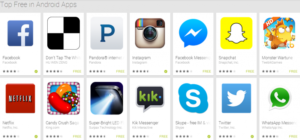Many have opined about Facebook’s two major strategies over the last couple of years. The first is their aggressive stance on acquisitions, a 180 from their acquihire only approach pre-IPO. This includes Instagram, WhatsApp, Moves, and the real outlier Oculus. The second and more recent is their unbundling of core functionality from the main Facebook app, as with a standalone Messenger app, a standalone Camera app (now being replaced by Instagram), a standalone ephemeral messaing app (Poke and now soon Slingshot), and a standalone launcher app (the miserable failure Facebook Home). One might think I am against such a strategy due to my previous post criticizing unbundling. What Facebook is attempting is something different though.
It is rare that companies get to a point where they start to pursue a moat strategy. A moat strategy makes sense when a core business is so profitable that the most sensible course of action is to build things around it to protect it instead of trying to increase value of customers or try to attract more customers. Google is a famous example of this with Adwords. Its core business is so successful that it pursues projects like free mobile operating system Android solely focused on protecting distribution of Adwords as the world shifted to mobile, and free web browser Chrome to protect distribution of Adwords on web as Microsoft tried to bundle browser (Internet Explorer) and search (Bing) together.
While an entire company ascending so far to the top that its main course of action is building a moat is rare; it is more common on specific distribution channels. Take, for example, search engine marketing and search engine optimization. Once you ascend to the #1 result for an organic search, a normal marketer might stop there and try to optimize other channels. But savvy search engine marketers are just getting started then. A savvy search marketer knows that a #1 result organically does not guarantee that all clicks go to one’s own domain. There are still nine other organic spots and the paid ads, which may still appear above your result. So hardcore search marketers start working on their next trick, owning more than one spot on the search result.
I pursued this strategy at Homefinder. We would take the #1 ranking for certain keywords like “Fayetteville homes for sale”. Once we achieved this, we would bid highly on Adwords as well to take a second spot on the page. Then, we would work with affiliate marketers to bid below us in Adwords to take the second, third, fourth, etc. spots on the page. If someone clicked on those listings, they would go to a different website (as Google only allows one paid ad per domain). But when someone searched on those domains, they were redirected to Homefinder. By pursuing this strategy, we could own perhaps five or so spots on Google for one search, making the likelihood of someone landing on Homefinder much higher than if we just had the #1 spot and nothing else.
The travel companies like Expedia are the masters of this, with multiple brands ranking on the top of Google that are all owned by the same conglomerate not very differentiated. Almost all travel purchases start with Google, so the travel companies maximize this distribution channel more than any other category. For example, Expedia has Hotwire, Hotels.com, and Trivago. Priceline has Booking.com, Kayak, and Agoda.
You might ask what this has to do with what Facebook is doing. Well, on mobile, Google is actually not the only search engine of note. The App Store and Google Play are just as important to optimize for. App store rankings are largely determined by recent download counts, but Google Play is a bit more sophisticated with many engagement metrics. Facebook currently ranks #1 for free apps on Google Play. Did Facebook stop there? No, it unbundled it’s Messenger app completely, which is now the #5 free app. It purchased Instagram, which is the #4 free app. It tried to buy Snapchat, which is the #6 free app. And it purchased WhatsApp, which is the #14 free app. When you already own the top result, you tried to grab as much of the rest of the top real estate as you can.

If Facebooked buys Pandora in the future, don’t be so shocked. This is not just true on the app search engines though. The home screen of the mobile phone is another limited piece of real estate that is incredibly important. Facebook is likely on the home screen of more mobile users than any other app. But it is still only one app among many one can click on when they pick up their phone. So Facebook is focusing on other app that already have wide home screen distribution. I had Facebook, Instagram, and Moves on my home screen. That means, Facebook had a 3/16 chance every time I opened my phone that they would receive some sort of engagement from me.
When you’re optimizing channels, I encourage you to think about the real estate you own on each one, and how you can own more. It’s an incredibly effective strategy even if you’re not quite at the moat building stage.


